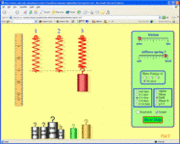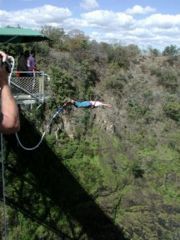TestLesson
| Hooke's Law |
Introduction | Preknowledge | Objectives | Activities | Conclusion | Resources | Definitions |
Introduction
This is an interactive science activity (ISA) that uses the Mass and Spring Flash simulation to explore Hooke's Law. The simulation was created by the Physics Education Technology Team (PhET) at the University of Colorado.
Hooke's law is everywhere! We find it applies to solids, liquids, and gases in many fields of physics. The simplest way to see Hooke's law in action is to observe springs, pendulums, or balls in a bowl. It leads to the description of simple harmonic motion and waves, including sound and light waves. Do you want to understand light, sound, the configurations of DNA? Follow me to where it all starts!
One of the most heart stopping applications of Hooke's law is Bungee (or Bungy) jumping as featured in the opening scene of GoldenEye, the 17th James Bond 007 film released in 1995. To make sure that the bungy cord is not too long, bungy operators like Kiwi A.J. Hackett, the first operator of a commercial bungee jump, need to calculate how far the cord will stretch.
Hooke's law also allows us to control light, and our eyes are just one example of a highly evolved material the controls light and directs it to the optic nerve. Small imperfections cause us to be short- or far-sighted. Enter the optometrist, the eye doctor, who again applies Hooke's law to correct our vision with glasses or contact lenses.
| Hooke's law | |
| Wikipedia has an article on this subject.
Visit Hooke's law for more in depth information |
To complete these activities you will need:
|
The Hooke's law interactive science activity consists of:
|
| These activities should take you between 30 and 45 minutes to complete. If you are far from completion after 40 minutes you should contact your teacher. |
| Hooke's Law |
Introduction | Preknowledge | Objectives | Activities | Conclusion | Resources | Definitions |

